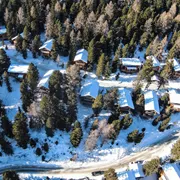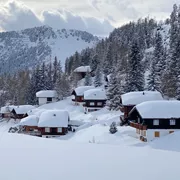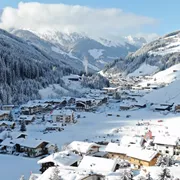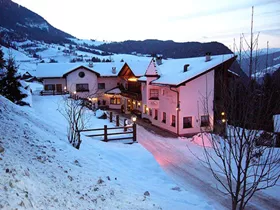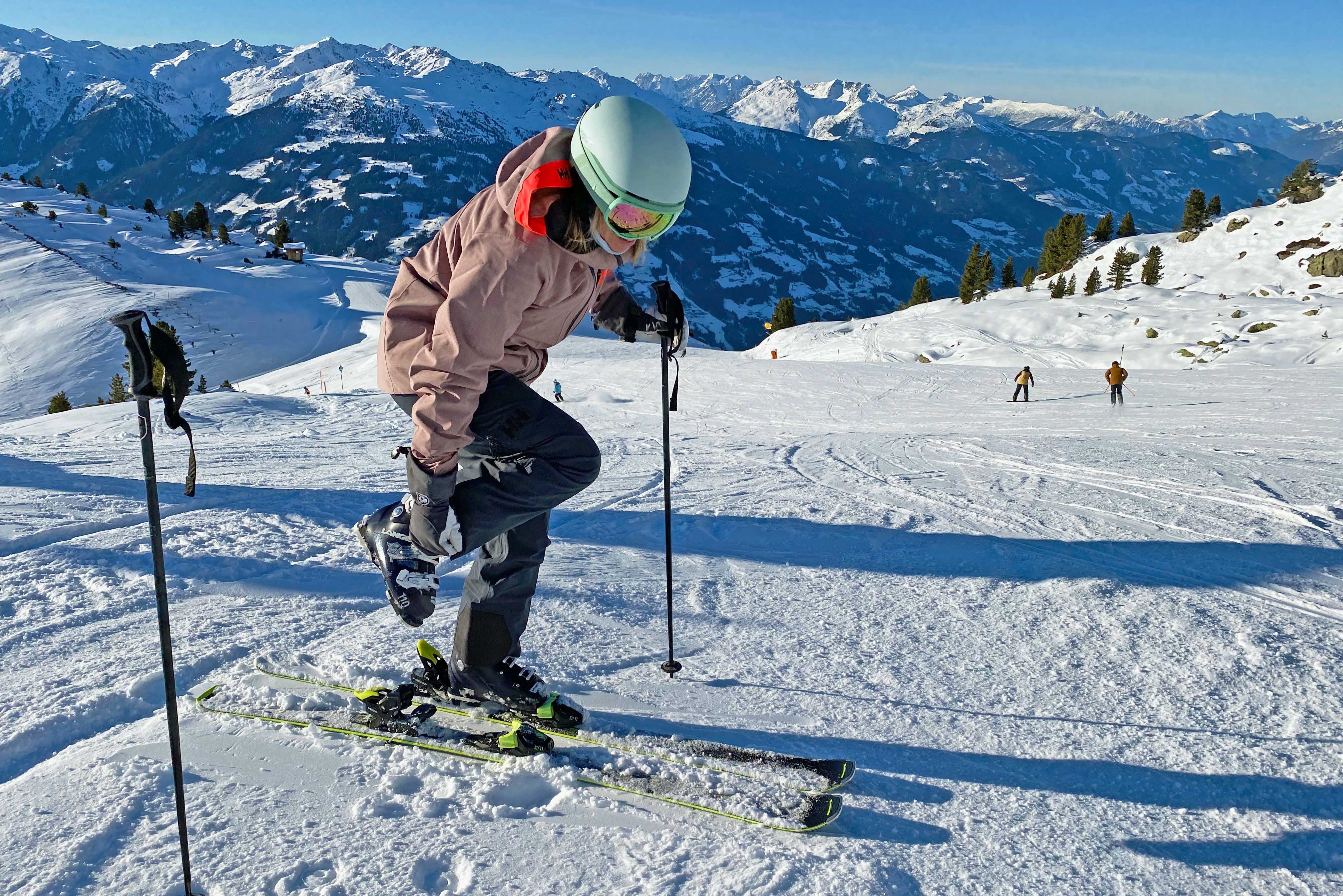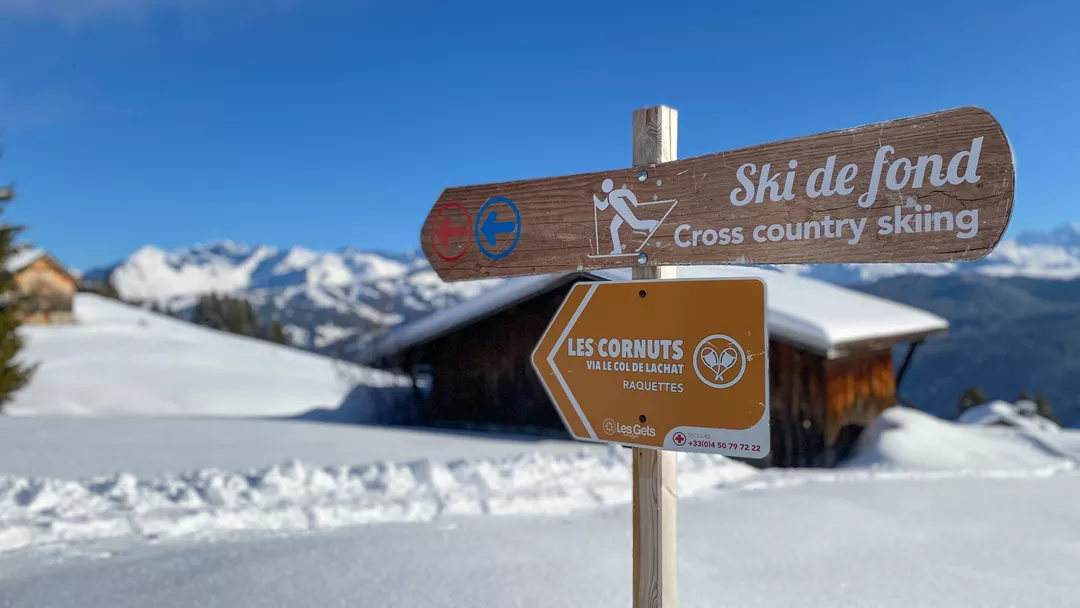
Cross-country skiing is one of the best activities for anyone who wants to keep active while exploring the winter landscape. It’s a chance to relax and be one with nature while still getting your adrenaline levels up. While it’s quite the workout, cross-country skiing is easier to learn than downhill skiing or snowboarding – many people manage to pick it up in the course of a morning. If you’re not convinced about downhill skiing but you want to get out there on skis, cross-country skiing is a cheaper and safer way to do so.
Many destinations in the Alps offer prepared cross-country skiing trails. Most of these trails run through the valleys, but certain ski areas also have special high-altitude trails with guaranteed snow or special Nordic skiing parks. If you’d like to go cross-country skiing on your winter holidays, it pays to choose a region which always has open trails. On this page you’ll find everything you need to know about planning a cross-country skiing holiday. From cross-country skiing equipment to the best cross-country skiing destinations, here is a full overview of this Nordic sport.
Skip to:
- Cross-country skiing in Austria
- Cross-country skiing in Germany
- Cross-country skiing in Italy
- Cross-country skiing in Switzerland
- Cross-country skiing in France
- Clothing and equipment
- Planning your cross-country skiing trip
- Technique
 Cross-country skiing in Austria
Cross-country skiing in Austria
Austria is full of wonderful cross-country skiing destinations: Tyrol, Vorarlberg, Steiermark, Salzburg and Carinthia spring to mind, among others. Many places have opted to specialise in cross-country skiing, and these are the best destinations for a cross-country skiing holiday. At these ski areas you’ll often find floodlit night trails, special facilities and various cross-country skiing events.
-
Top 5 cross-country destinations in Austria
1: Olympiaregion Seefeld (279km of trails)
2: Tannheimer Tal (140km of trails)
3: Achensee (211km of trails)
4: St. Johann in Tirol (250km of trails)
5: Ramsau am Dachstein (220km of trails) -
Top 5 cross-country routes in Austria
1: Tauern (60km), Salzburger Sportwelt
2: Pinzga (200km), e.g. Mittersill
3: Dachstein-Runde (28km), Dachstein
4: Fuchsmoos (8km), Pitztal
5: Gaichtpass (18km), Tannheimer Tal
 Cross-country skiing in Germany
Cross-country skiing in Germany
Germany has outstanding cross-country skiing. From Sauerland to the forests of Bavaria, this is one of Europe’s best destinations for cross-country skiing. The Black Forest alone has 700km of prepared routes! Germany’s trails are generally easier than the trails you’ll find in the Alps, with less of a change in altitude. Just remember to check the snow report before you go cross-country skiing in one of the lower-altitude German ski areas, because snow cover can be unreliable here.
-
Top 5 cross-country destinations in Germany
1: Kleinwalsertal & Oberstdorf (140km of trails)
2: Berchtesgadener Land (100km of trails)
3: Chiemgauer Alpen (150km of trails)
4: Oberammergau (100km of trails)
5: Willingen (100km of trails) -
Top 5 cross-country routes in Germany
1: König Ludwig (50km), Ammergauer Alpen
2: Spielmannsau (15km), Oberstdorf
3: 3 Lakes (12km), Ruhpolding
4: Thurnerspur (16km), Black Forest
5: Rothaar (54km), e.g. Winterberg

 Cross-country skiing in Italy
Cross-country skiing in Italy
Italy is a picturesque cross-country skiing destination. Most of the trails are located higher up in the mountains, which means you’ll usually be skiing with incredible views of the Dolomites! Here you’ll also find the Dolomiti Nordicski, the largest cross-country skiing region in Europe with 1300km of trails spread over 12 ski areas. Beginners, don’t be intimidated by the high-altitude trails: places like the Seiser Alm offer plateaus with routes that are less challenging.
-
Top 5 cross-country destinations in Italy
1: Hochpustertal (200km of trails)
2: Kronplatz (175km of trails)
3: Seiser Alm (80km of trails)
4: Val Gardena (133km of trails)
5: Cortina d’Ampezzo (156km of trails) -
Top 5 cross-country routes in Italy
1: Pustertaler Marathon(60km), Hochpustertal
2: Joch (15km), Seiser Alm
3: Lago di Tesero (10km), Val di Fiemme
4: Würzjoch (4km), Kronplatz
5: Marianna Longa, Livigno
 Cross-country skiing in Switzerland
Cross-country skiing in Switzerland
Switzerland boasts an astounding 5000km of cross-country skiing trails, with something for every level. From high-altitude trails with guaranteed snow, to relaxing routes through the Jura, everyone is sure to find a fun challenge in Switzerland. Experienced cross-country skiers, don’t miss the chance to take part in the Engadin Ski Marathon. This annual event sees more than 10 000 people take part in a 42km cross-country skiing race.
-
Top 5 cross-country destinations in Switzerland
1: Engadin (220km of trails)
2: Davos-Klosters (175km of trails)
3: Gstaad (175km of trails)
4: Arosa-Lenzerheide (86km of trails)
5: Kandersteg (55km of trails) -
Top 5 cross-country routes in Switzerland
1: Engadin Marathon (42km), Engadin
2: Rosegtal (7km), Pontresina
3: Saastal (26km), Saas-Fee
4: Safiental of trails (8km), Davos
5: Userntal (28km), Andermatt
 Cross-country skiing in France
Cross-country skiing in France
Cross-country skiing hasn’t caught on as much in France, and there are less destinations that specialise in cross-country skiing. This doesn’t mean it’s impossible to have a nice cross-country skiing holiday in France, just that you’ll need to make a bit more effort to inform yourself before going. Most of the ski resorts that offer cross-country skiing trails are located at lower altitudes, such as the Vogezen or the Jura. Look for a ski resort with an “Espace Nordique”.
-
Top 5 cross-country destinations in France
1: Les Saisies (120km of trails)
2: Le Grand Bornand (65km of trails)
3: La Clusaz (50km of trails)
4: Les Rousses (220km of trails)
5: Bessans (133km of trails) -
Top 5 cross-country routes in France
1: Espace Nordique Les Guibertes, Serre Chevalier
2: Espace Nordique Val-des-Prés/Les Alberts, Montgenèvre
3: Manchet (6.5km), Val d’Isère
4: Bouc Blanc (5km), Courchevel
5: Col de Pierre Carrée (at 1844m!), Flaine
Cross-country skiing technique: classic or skate?
Cross-country skiing can be divided into two main styles: classic and skate. Both have several different styles, but the main difference between classic and skate cross-country skiing is that classic cross-country skiing is done in a track, while skate cross-country skiing is done on a regular trail, with the skis pointing outwards in a V-shape. Most people agree that the classic style is more approachable for beginners.

Cross-country skiing: clothing and gear
Trying out cross-country skiing is fairly easy. It doesn’t require much in terms of specialised gear – just cross-country skis, boots and poles – and you can rent these at the ski resort before deciding if you want to invest in your own.
- Cross-country skis: The length of your cross-country skis will depend on your preferred technique. Modern skate skis are about the same length as than your body, while classic skating ski’s are about 20cm longer.
- Cross-country skiing boots: Cross-country skiing boots are more flexible than regular ski boots, but they must be sturdy and waterproof. Your shoes are attached to the skis only by the front of the bindings.
- Cross-country skiing outfit: For cross-country skiing you can wear more or less what you would wear for downhill skiing. The most important difference is that cross-country skiing is harder work, so you won’t want to dress quite as warmly. If you plan to make a habit of cross-country skiing, you may want to invest in cross-country ski clothing. This entails waterproof trousers, thermals and a softshell or hardshell jacket, as well as gloves and a beanie. Cross-country skiing is fairly strenuous and it might take a few tries to find an outfot that balances the cold weather with your high activity level.
Cross-country skiing prep: working on your fitness and balance
Cross-country skiing is relatively easy to pick up and as such it’s suitable for a wide range of people. That being said, there are a few exercises you can, and should, work on at home in order to be well-prepared for your cross-country skiing trip. The first order of business is getting in shape – you may want to try these 5 exercises – and working on your balance and coordination. Hiking, cycling and rollerblading are good ways to prepare yourself for cross-country skiing. However, even if your fitness isn’t at its highest point, the nice part about cross-country skiing is that almost anyone can do it, from kids to grandparents. If you don’t feel comfortable tackling a difficult trail right off the bat, there’s absolutely nothing wrong with choosing a trail that’s not as steep or not as high up.
Why go cross-country skiing?
Cross-country skiing, boring? No way! Talk to almost anyone who’s tried it once and you’ll notice that they’ve become an instant convert. No lift queues, no expensive ski passes, no crowded slopes: cross-country skiing lets you enjoy nature at your own pace, with peace and quiet all around except for the rustling of animals in the trees and the swooshing sound of your skis gliding over the snow. It’s a solid workout with minimal risk of injury in a beautiful setting. There’s no need to wear uncomfortable ski boots or a helmet, and you can even bring your dog along with you!
1. Healthy
2. No lift queues
3. Get back to nature
4. Affordable winter sports activity
5. Little risk of injury
You might also like:
-
Mieming: The ski resort with no lifts

The tiny ski resort of Mieming has done away with lifts and is focusing all its energies on more sustainable sports like cross-country skiing.
-
10 funny cross-country skiing videos

Cross-country skiing has a reputation for being a lamer cousin to downhill skiing. Here are 10 videos that prove you can have a laugh with cross-country skiing too!

